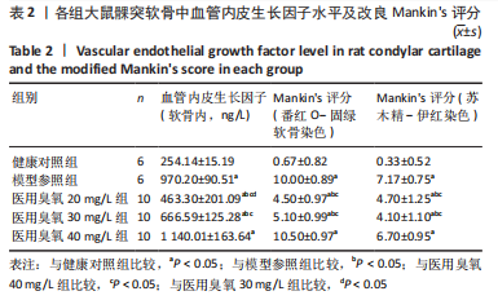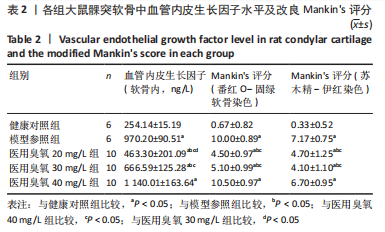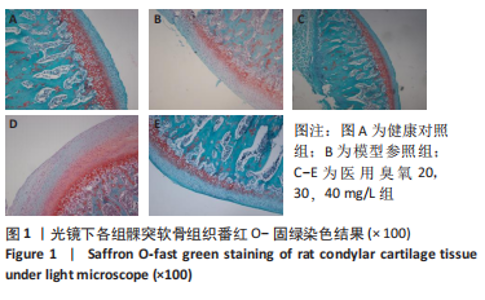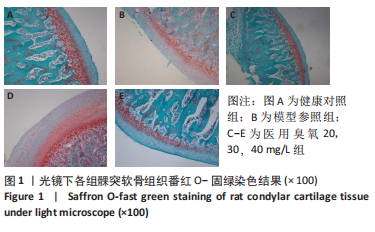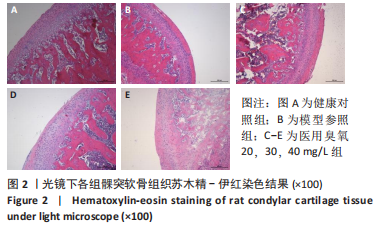[1] SPERRY MM, KARTHA S, WINKELSTEIN BA, et al. Experimental Methods to Inform Diagnostic Approaches for Painful TMJ Osteoarthritis. J Dent Res. 2019;98(4):388-397.
[2] WANG XD, ZHANG JN, GAN YH, et al. Current understanding of pathogenesis and treatment of TMJ osteoarthritis. J Dent Res. 2015; 94(5):666-673.
[3] 段鑫,李奇,林荔军,等.骨关节炎滑膜组织中缺氧诱导因子-1α、血管内皮生长因子的表达[J].南方医科大学学报,2011,31(1):117-120.
[4] FRANSÈS RE, MCWILLIAMS DF, MAPP PI, et al. Osteochondral angiogenesis and increased protease inhibitor expression in OA. Osteoarthritis Cartilage. 2010;18(4):563-571.
[5] ZHANG S, CAO W, WEI K, et al. Expression of VEGF-receptors in TMJ synovium of rabbits with experimentally induced internal derangement. Br J Oral Maxillofac Surg. 2013;51(1):69-73.
[6] 蔡恒星,柯金,孟庆功,等.透明质酸注射联合咀嚼肌功能训练治疗老年性颞下颌关节骨关节炎患者的临床研究[J].口腔医学研究, 2019,35(3):262-265.
[7] 乔祺惠,周青.颞下颌关节骨关节病物理及药物治疗研究进展[J].中国实用口腔科杂志,2018,11(9):557-563.
[8] SALAMANNA F, GIAVARESI G, PARRILLI A, et al. Effects of intra-articular hyaluronic acid associated to Chitlac (arty-duo®) in a rat knee osteoarthritis model. J Orthop Res. 2019;37(4):867-876.
[9] KENMOCHI M. Clinical outcomes following injections of leukocyte-rich platelet-rich plasma in osteoarthritis patients. J Orthop. 2019;18:143-149.
[10] 李海群,张志仕,李博,等.医用臭氧水对兔膝关节骨性关节炎软骨p38MAPK、ERK与JNK表达的影响[J].解剖科学进展,2018,24(2): 126-128.
[11] 李来月,金鸿宾,万春友,等.医用臭氧关节腔内注射对膝关节骨性关节炎大鼠疗效研究[J].亚太传统医药,2017,13(13):9-11.
[12] 满城,张碧,马永清,等.关节腔注射TGF-1治疗兔颞下颌关节骨关节炎的实验研究[J].临床口腔医学杂志,2009,25(12):714-717.
[13] PRITZKER KP, GAY S, JIMENEZ SA, et al. Osteoarthritis cartilage histopathology: grading and staging. Osteoarthritis Cartilage. 2006; 14(1):13-29.
[14] ROY H, BHARDWAJ S, YLÄ-HERTTUALA S. Biology of vascular endothelial growth factors. FEBS Lett. 2006;580(12):2879-2887.
[15] JANSEN H, MEFFERT RH, BIRKENFELD F, et al. Detection of vascular endothelial growth factor (VEGF) in moderate osteoarthritis in a rabbit model. Ann Anat. 2012;194(5):452-456.
[16] NAGAI T, SATO M, KUTSUNA T, et al. Intravenous administration of anti-vascular endothelial growth factor humanized monoclonal antibody bevacizumab improves articular cartilage repair. Arthritis Res Ther. 2010;12(5):R178.
[17] 邓力,张清彬,张颖,等.臭氧治疗颞下颌关节炎的临床研究[J].口腔医学研究,2016,32(11):1208-1210.
[18] FENG X, BEIPING L. Therapeutic Efficacy of Ozone Injection into the Knee for the Osteoarthritis Patient along with Oral Celecoxib and Glucosamine. J Clin Diagn Res. 2017;11(9):UC01-UC03.
[19] LOPES DE JESUS CC, DOS SANTOS FC, DE JESUS LMOB, et al. Comparison between intra-articular ozone and placebo in the treatment of knee osteoarthritis: A randomized, double-blinded, placebo-controlled study. PLoS One. 2017;12(7):e0179185.
[20] 马志坤,傅志俭,孙涛,等.医用臭氧对膝骨关节炎兔软骨基质金属蛋白酶-1的影响[J].中华麻醉学杂志,2007,27(12):1107-1109.
[21] VAN DEN BERG WB. Osteoarthritis year 2010 in review: pathomechanisms. Osteoarthritis Cartilage. 2011;19(4):338-341.
[22] KVAM BJ, FRAGONAS E, DEGRASSI A, et al. Oxygen-derived free radical (ODFR) action on hyaluronan (HA), on two HA ester derivatives, and on the metabolism of articular chondrocytes. Exp Cell Res. 1995;218(1):79-86.
[23] 史丽璞,王旭,郇稳.医用臭氧对膝骨关节炎患者疼痛程度、关节功能及血清NO、SOD、MDA的影响[J].风湿病与关节炎,2021,10(2): 11-14.
[24] TIRELLI U, CIRRITO C, PAVANELLO M, et al. Ozone therapy in 65 patients with fibromyalgia: an effective therapy. Eur Rev Med Pharmacol Sci. 2019;23(4):1786-1788.
[25] 杨妮娜,詹景棣,柳海晓,等.臭氧通过调节HIF-1α-VEGF信号通路治疗类风湿关节炎的实验研究[J].浙江医学,2019,41(21):2265-2268.
[26] TANG N, WANG L, ESKO J, et al. Loss of HIF-1alpha in endothelial cells disrupts a hypoxia-driven VEGF autocrine loop necessary for tumorigenesis. Cancer Cell. 2004;6(5):485-495.
[27] MUZ B, KHAN MN, KIRIAKIDIS S, et al. Hypoxia. The role of hypoxia and HIF-dependent signalling events in rheumatoid arthritis. Arthritis Res Ther. 2009;11(1):201.
[28] 赵利剑,王平,郎建伟,等.医用臭氧注射联合加味四妙汤治疗慢性膝关节滑膜炎50例临床观察[J].湖南中医杂志,2018,34(1):71-73.
[29] 韦英成,吴肖梅,梁晓行,等.医用臭氧水穴位注射结合颈椎牵引治疗椎动脉型颈椎病的临床观察[J].中华全科医学,2020,18(6): 1014-1017.
[30] 李泓锡,姚鹏.医用臭氧配合羟考酮缓释剂治疗中重度癌痛的临床观察[J].中国现代医学杂志,2018,28(22):49-53.
|
